Conducting a Geographical Information System-Based Multi-Criteria Analysis to Assess the Potential and Location for Offshore Wind Farms in Poland
Abstract
1. Introduction
- What are the key aspects that should be considered while deciding on an offshore wind farm location?
- Which spatial data sets are crucial to determine optimal offshore wind farm locations using QGIS software?
- What are the suitable sites for offshore wind farm development in the Polish part of the Baltic Sea other than those proposed in the Act [31]?
- What is the technical potential of offshore wind in the Polish part of the Baltic Sea?
2. Optimisation of Offshore Wind Farm Locations
2.1. Energy Resources and Profitability
2.2. Conservation Area and View Protection
2.3. Human Activities
2.4. Marine Environment and Marine Ecology
3. Methodology
3.1. Proposed Framework
3.2. Criteria Selection
3.3. Analytic Hierarchy Process
- Provides a straightforward solution;
- Can be applied in computer software;
- Can address a wide range of complex decision problems;
3.4. Criteria Classification
3.5. Assumptions
4. Results
4.1. Excluded Areas
4.2. Suitable Areas
4.3. Offshore Wind Potential of the EEZ of Poland
4.4. Validation of the Results against Real Investment Plans
5. Summary and Conclusions
Author Contributions
Funding
Data Availability Statement
Conflicts of Interest
Appendix A
| Importance | Definition | Explanation |
|---|---|---|
| 1 | Equal importance | Two sub-objectives contribute equally to the objective |
| 3 | Weak importance of one over the other | Experience and judgement slightly favour one over another |
| 5 | Essential or strong importance | Experience and judgement strongly favour one over another |
| 7 | Demonstrated importance | A sub-objective is strongly favoured, and its dominance is demonstrated in practice |
| 9 | Absolute importance | The evidence favouring one sub-objective or another is of the highest possible order of affirmation |
| 2, 4, 6, 8 | Intermediate values | A compromise is needed |
| Criteria | 1 | 2 | 3 | 4 | 5 | 6 | 7 | 8 | |
|---|---|---|---|---|---|---|---|---|---|
| Wind Velocity | Water Depth | Distance from Nature Conservation Areas (Natura 2000) | Distance from Submarine Cables and Gas Pipelines | Distance from Shipping Routes | Fishing Areas | Distance from Shipwrecks | Distance from Coastline | ||
| 1 | wind velocity | 1 | 3 | 5 | 7 | 7 | 5 | 7 | 4 |
| 2 | water depth | 0.33 | 1 | 4 | 5 | 5 | 4 | 5 | 0.33 |
| 3 | distance from nature conservation areas (Natura 2000) | 0.20 | 0.25 | 1 | 3 | 3 | 4 | 3 | 0.25 |
| 4 | distance from submarine cables and gas pipelines | 0.14 | 0.20 | 0.33 | 1 | 2 | 3 | 2 | 0.20 |
| 5 | distance from shipping routes | 0.14 | 0.20 | 0.33 | 0.50 | 1 | 2 | 0.33 | 0.17 |
| 6 | fishing areas | 0.20 | 0.25 | 0.25 | 0.33 | 0.50 | 1 | 0.33 | 0.17 |
| 7 | distance from shipwrecks | 0.14 | 0.20 | 0.33 | 0.50 | 3 | 3 | 1 | 0.20 |
| 8 | distance from coastline | 0.25 | 3 | 4 | 5 | 6 | 6 | 5 | 1 |
References
- ‘Fit for 55’: Delivering the EU’s 2030 Climate Target on the Way to Climate Neutrality. Communication from the Commission to the European Parliament, the Council, the European Economic and Social Committee and the Committee of the Regions; European Commission: Brussels, Belgium, 2021; Available online: https://eur-lex.europa.eu/legal-content/EN/TXT/?uri=CELEX%3A52021DC0550 (accessed on 1 May 2023).
- Esteban, M.D.; Diez, J.J.; López, J.S.; Negro, V. Why Offshore Wind Energy? Renew. Energy 2011, 36, 444–450. [Google Scholar] [CrossRef]
- V236-15.0 MWTM at a Glance. Available online: https://www.vestas.com/en/products/offshore/V236-15MW (accessed on 1 May 2023).
- Ramírez, L. Offshore Wind Energy 2022 Statistics; WindEurope: Brussels, Belgium, 2023. [Google Scholar]
- Ramírez, L.; Brindley, G. Offshore Wind Energy 2021 Statistics; WindEurope: Brussels, Belgium, 2022. [Google Scholar]
- Cecchinato, M. Boosting Offshore Wind Energy in the Baltic Sea; WindEurope: Brussels, Belgium, 2019. [Google Scholar]
- Pluta, M.; Wyrwa, A.; Suwała, W.; Zyśk, J.; Raczyński, M.; Tokarski, S. A Generalized Unit Commitment and Economic Dispatch Approach for Analysing the Polish Power System under High Renewable Penetration. Energies 2020, 13, 1952. [Google Scholar] [CrossRef]
- European Union Study On Baltic Offshore Wind Energy Cooperation Under BEMIP; Final Report ENER/C1/2018-456; European Union: Brussels, Belgium, 2019; Available online: https://op.europa.eu/en/publication-detail/-/publication/9590cdee-cd30-11e9-992f-01aa75ed71a1 (accessed on 1 May 2023).
- Olczak, P.; Surma, T. Energy Productivity Potential of Offshore Wind in Poland and Cooperation with Onshore Wind Farm. Appl. Sci. 2013, 13, 4258. [Google Scholar] [CrossRef]
- Ziemba, P. Multi-Criteria Fuzzy Evaluation of the Planned Offshore Wind Farm Investments in Poland. Energies 2021, 14, 978. [Google Scholar] [CrossRef]
- Ziemba, P. Uncertain Multi-Criteria Analysis of Offshore Wind Farms Projects Investments—Case Study of the Polish Economic Zone of the Baltic Sea. Appl. Energy 2022, 309, 118232. [Google Scholar] [CrossRef]
- Pronińska, K.; Księżopolski, K. Baltic Offshore Wind Energy Development—Poland’s Public Policy Tools Analysis and the Geostrategic Implications. Energies 2021, 14, 4883. [Google Scholar] [CrossRef]
- Offshore Wind Technical Potential|Analysis and Maps. Available online: https://www.esmap.org/esmap_offshorewind_techpotential_analysis_maps (accessed on 1 May 2023).
- Polityka Energetyczna Polski Do 2040 r.; Ministerstwo Klimatu i Środowiska: Warsaw, Poland, 2021. Available online: https://www.gov.pl/web/klimat/polityka-energetyczna-polski (accessed on 1 May 2023).
- Pogorzelski, K.; Mitraszewski, K.; Matczak, M.; Pardus, J.; Szydłowski, Ł.; Zaucha, J.; Jensen, J.F.; Brezgin, M.; Scheffler, R.; Foy, M.; et al. KP Consulting, Instytut Morski Uniwersytetu Morskiego w Gdyni, Ramboll, DWF Potencjał Morskiej Energetyki Wiatrowej w Polsce; PSEW: Szczecin, Poland, 2022; Available online: https://konferencja-offshore.pl/wp-content/uploads/2022/11/FarmyMorskie_RaportShort_Prev.pdf (accessed on 1 May 2023).
- The Future of Offshore Wind in Poland; Polish Wind Energy Association: Warsaw, Poland, 2019; Available online: http://psew.pl/en/wp-content/uploads/sites/2/2019/09/The-future-of-offshore-wind-in-Poland-PWEA-Report.pdf (accessed on 1 May 2023).
- Michaelides, E.E. Alternative Energy Sources; Green Energy and Technology; Springer: Berlin/Heidelberg, Germany, 2012; ISBN 978-3-642-20950-5. [Google Scholar]
- Quaschning, V. Understanding Renewable Energy Systems; Earthscan: London, UK; Sterling, VA, USA, 2005; ISBN 978-1-84407-128-9. [Google Scholar]
- Kalyan, V.; Xiang, Y.; O’Reill, U. Statistical Approaches for Wind Resource Assessment. In Computational Intelligent Data Analysis for Sustainable Development; Chapman and Hall/CRC: New York, NY, USA, 2013. [Google Scholar]
- Anjum, L. Wind Resource Estimation Techniques-An Overview. Int. J. Wind Renew. Energy 2014, 3, 26–38. [Google Scholar]
- Mortensen, N.G. Wind Resource Assessment Using the WAsP Software; E No. 174; DTU Wind Energy: Roskilde, Denmark, 2018. [Google Scholar]
- Murthy, K.S.R.; Rahi, O.P. A comprehensive review of wind resource assessment. Renew. Sustain. Energy Rev. 2017, 72, 1320–1342. [Google Scholar] [CrossRef]
- Cavazzi, S.; Dutton, A.G. An Offshore Wind Energy Geographic Information System (OWE-GIS) for Assessment of the UK’s Offshore Wind Energy Potential. Renew. Energy 2016, 87, 212–228. [Google Scholar] [CrossRef]
- Kim, T.; Park, J.-I.; Maeng, J. Offshore Wind Farm Site Selection Study around Jeju Island, South Korea. Renew. Energy 2016, 94, 619–628. [Google Scholar] [CrossRef]
- Hong, L.; Möller, B. Offshore Wind Energy Potential in China: Under Technical, Spatial and Economic Constraints. Energy 2011, 36, 4482–4491. [Google Scholar] [CrossRef]
- Möller, B.; Hong, L.; Lonsing, R.; Hvelplund, F. Evaluation of Offshore Wind Resources by Scale of Development. Energy 2012, 48, 314–322. [Google Scholar] [CrossRef]
- Caceoğlu, E.; Yildiz, H.K.; Oğuz, E.; Huvaj, N.; Guerrero, J.M. Offshore Wind Power Plant Site Selection Using Analytical Hierarchy Process for Northwest Turkey. Ocean Eng. 2022, 252, 111178. [Google Scholar] [CrossRef]
- Díaz, H.; Teixeira, A.P.; Guedes Soares, C. Application of Monte Carlo and Fuzzy Analytic Hierarchy Processes for Ranking Floating Wind Farm Locations. Ocean Eng. 2022, 245, 110453. [Google Scholar] [CrossRef]
- Lee, T.-L. Assessment of the Potential of Offshore Wind Energy in Taiwan Using Fuzzy Analytic Hierarchy Process. TOCIEJ 2010, 4, 96–104. [Google Scholar] [CrossRef][Green Version]
- Amsharuk, A.; Łaska, G. The Approach to Finding Locations for Wind Farms Using GIS and MCDA: Case Study Based on Podlaskie Voivodeship, Poland. Energies 2023, 16, 7107. [Google Scholar] [CrossRef]
- Ustawa z Dnia 17 Grudnia 2020 r. o Promowaniu Wytwarzania Energii Elektrycznej w Morskich Farmach Wiatrowych. 2020. Available online: https://isap.sejm.gov.pl/isap.nsf/DocDetails.xsp?id=WDU20210000234 (accessed on 1 May 2023).
- Chaouachi, A.; Covrig, C.F.; Ardelean, M. Multi-Criteria Selection of Offshore Wind Farms: Case Study for the Baltic States. Energy Policy 2017, 103, 179–192. [Google Scholar] [CrossRef]
- Exo, K.M.; Hüppop, O.; Garthe, S. Birds and Offshore Wind Farms: A Hot Topic in Marine Ecology. Wader Study Group Bull. 2003, 100, 50–53. [Google Scholar]
- Global Wind Atlas. Available online: https://globalwindatlas.info/en/ (accessed on 1 May 2023).
- System Informacji Przestrzennej Administracji Morskiej. Available online: https://sipam.gov.pl/ (accessed on 1 June 2023).
- European Marine Observation and Data Network (EMODnet). Available online: https://emodnet.ec.europa.eu/ (accessed on 1 May 2023).
- Saaty, R.W. The Analytic Hierarchy Process—What It Is and How It Is Used. Math. Model. 1987, 9, 161–176. [Google Scholar] [CrossRef]
- Saaty, T.L.; Kearns, K.P. The Analytic Hierarchy Process. In Analytical Planning; Elsevier: Amsterdam, The Netherlands, 1985; pp. 19–62. ISBN 978-0-08-032599-6. [Google Scholar]
- Halicka, K. Prospektywna Analiza Technologii: Metodologia i Procedury Badawcze; Oficyna Wydawnicza Politechniki Białostockiej: Białystok, Poland, 2016; ISBN 978-83-65596-05-5. [Google Scholar]
- Tatjana, A.; Pachemska; Lapevski, M.; Timovski, R. Analytical Hierarchical Process (AHP) Method Application in the Process of Selection and Evaluation. In Proceedings of the Hierarchical Process (AHP) Method Application in the Process, Gabrovo, Bulgaria, 21–22 November 2014. [Google Scholar]
- Stevens, R.J.A.M.; Hobbs, B.F.; Ramos, A.; Meneveau, C. Combining Economic and Fluid Dynamic Models to Determine the Optimal Spacing in Very Large Wind Farms: Combining Economic and Fluid Dynamic Models to Determine the Optimal Spacing in Very Large Wind Farms. Wind Energy 2017, 20, 465–477. [Google Scholar] [CrossRef]
- Meyers, J.; Meneveau, C. Optimal Turbine Spacing in Fully Developed Wind Farm Boundary Layers: Optimal Turbine Spacing in Wind Farm Boundary Layers. Wind Energy 2012, 15, 305–317. [Google Scholar] [CrossRef]
- Stevens, R.J.A.M.; Gayme, D.F.; Meneveau, C. Effects of Turbine Spacing on the Power Output of Extended Wind-Farms. Wind Energy 2016, 19, 359–370. [Google Scholar] [CrossRef]
- PGE and Orlen Group to Shape Phase II of Polish Offshore. Available online: https://balticwind.eu/pge-and-orlen-group-to-shape-phase-ii-of-polish-offshore/ (accessed on 1 May 2023).
- PGE Baltica Sp. z o.o. Available online: https://pgebaltica.pl/ (accessed on 1 May 2023).
- Baltic Power. Available online: https://www.balticpower.pl/ (accessed on 1 May 2023).
- Baltica 2+3. Available online: https://baltica.energy/en (accessed on 1 May 2023).
- BC-WIND. Available online: https://www.bc-wind.pl/en (accessed on 1 May 2023).
- F.E.W. Baltic II. Available online: https://fewbalticii.rwe.com/en (accessed on 1 May 2023).
- Morska Farma Wiatrowa MFW Bałtyk I. Available online: https://www.mfwbaltyk1.pl/ (accessed on 1 May 2023).
- Virtual Exhibition MFW Bałtyk II. Available online: https://wystawa.baltyk2.pl/en (accessed on 1 May 2023).
- Virtual Exhibition MFW Bałtyk III. Available online: https://wystawa.baltyk3.pl/en/ (accessed on 1 May 2023).
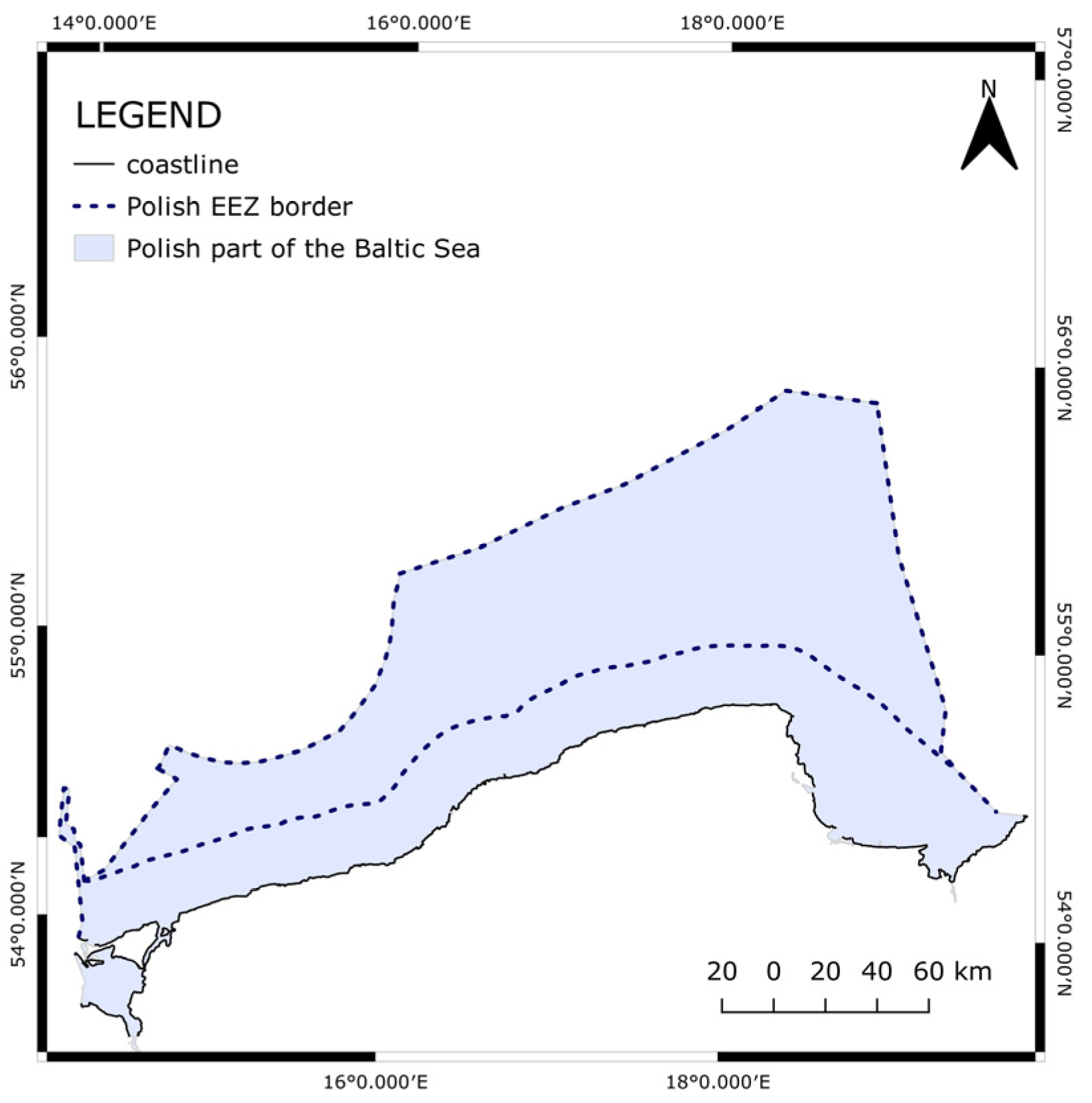
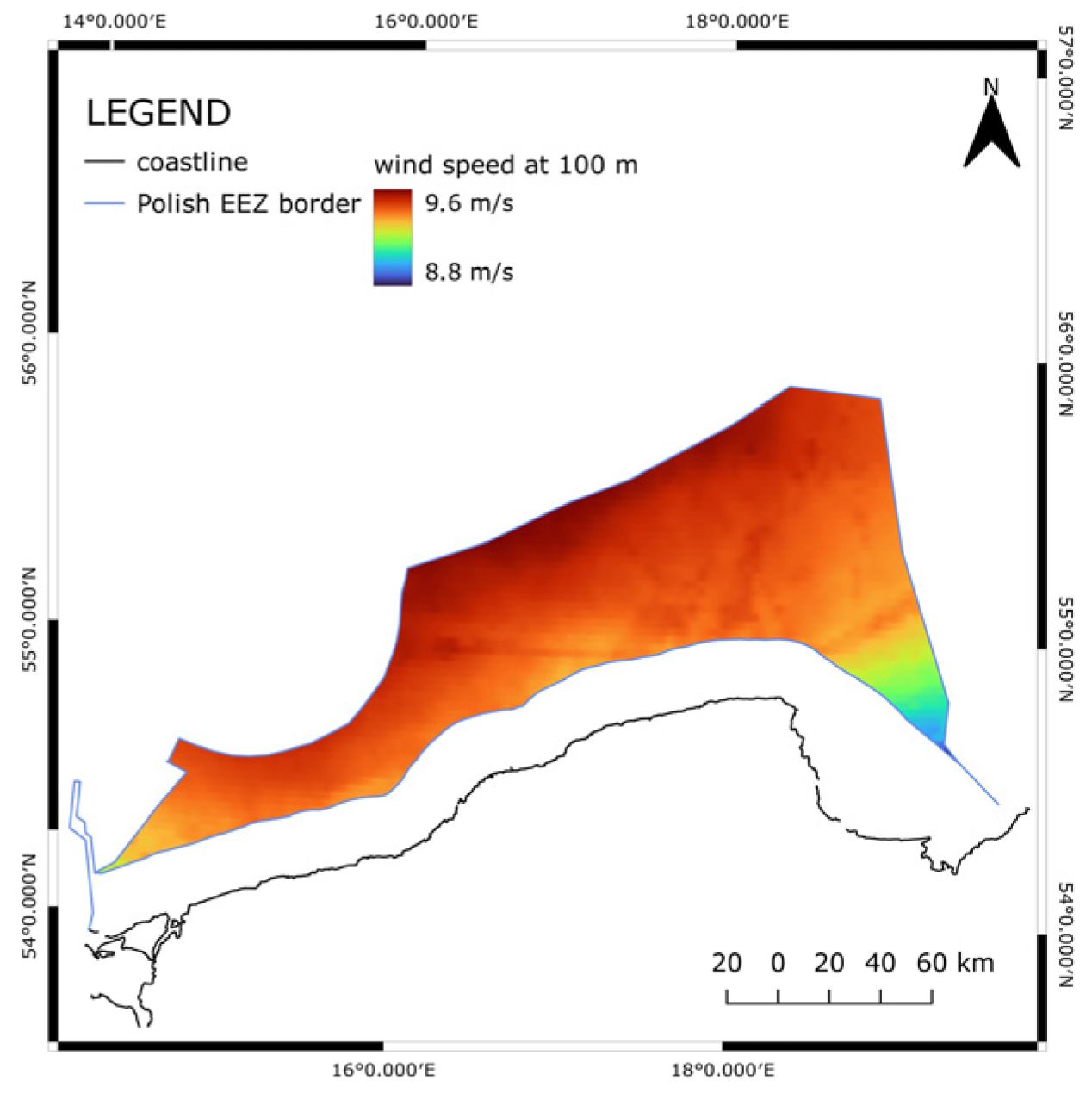
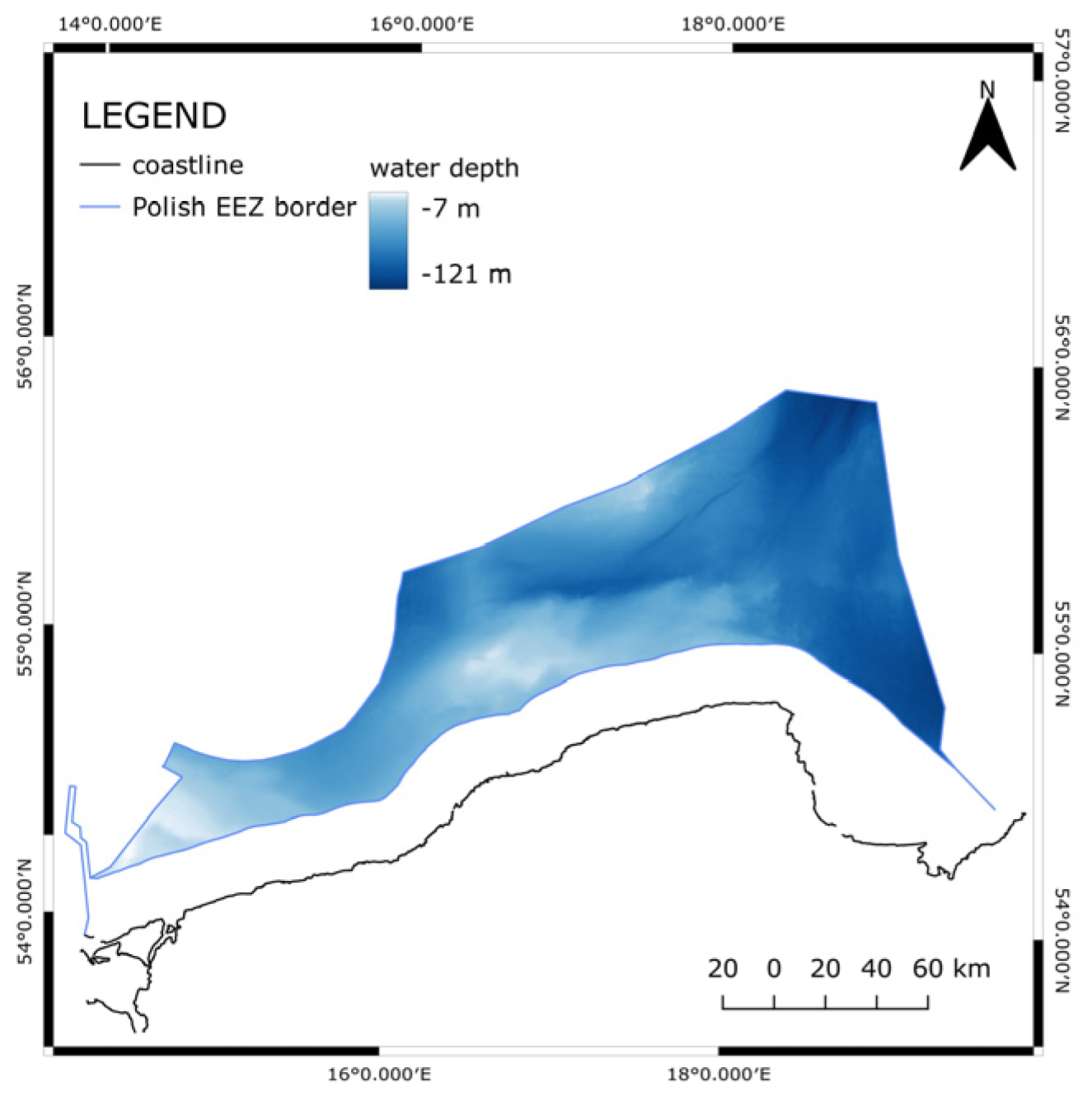
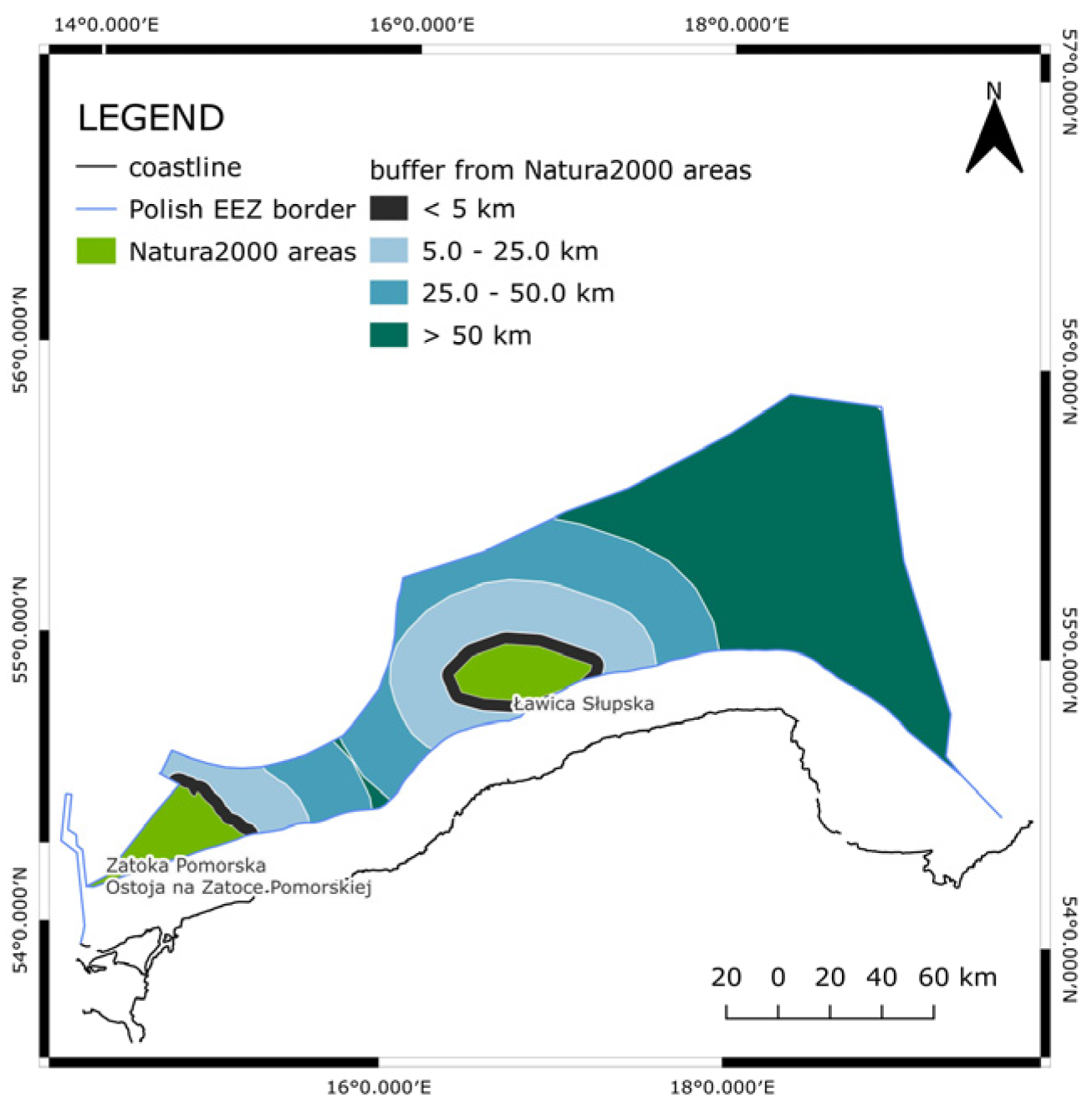


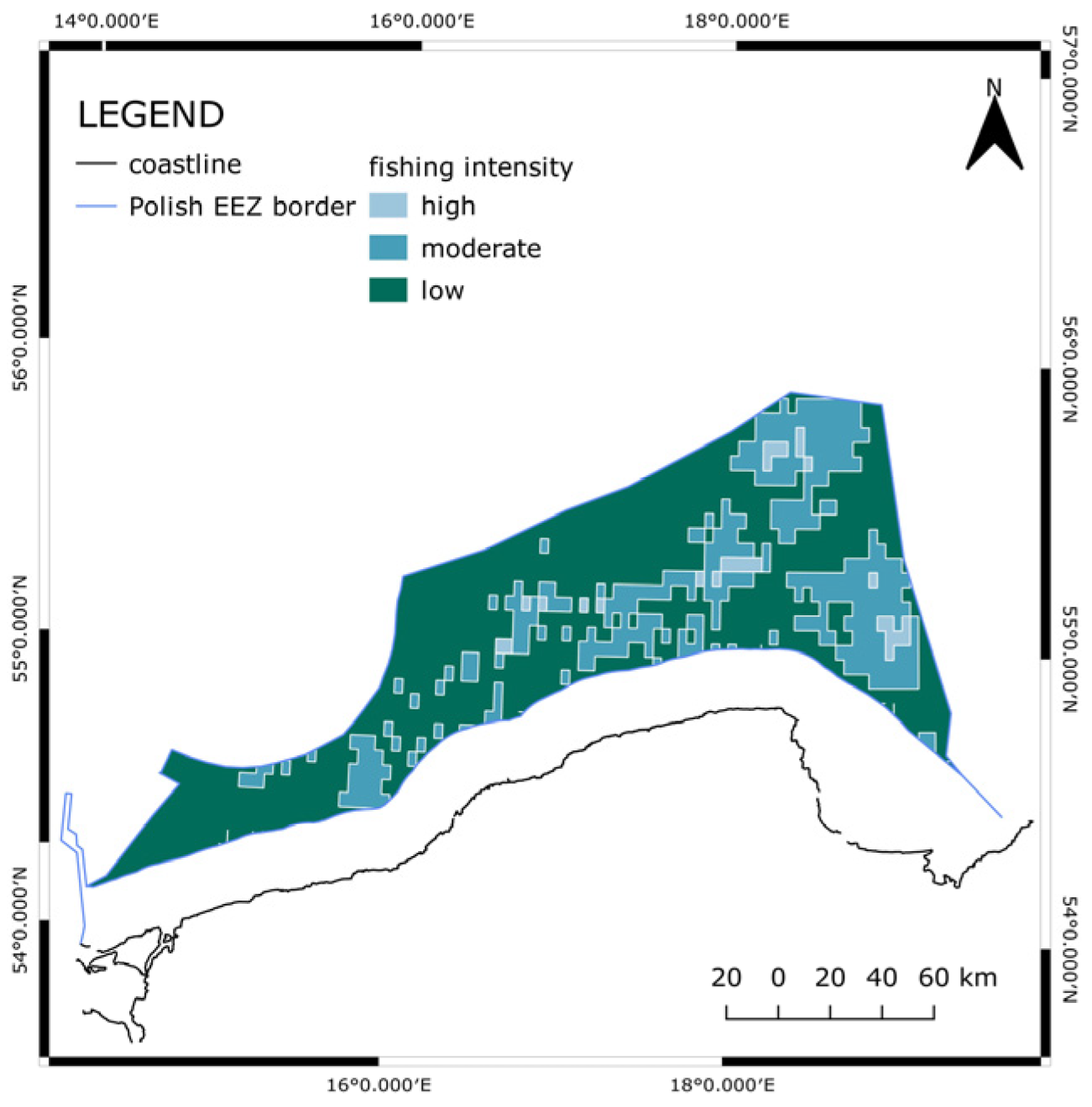
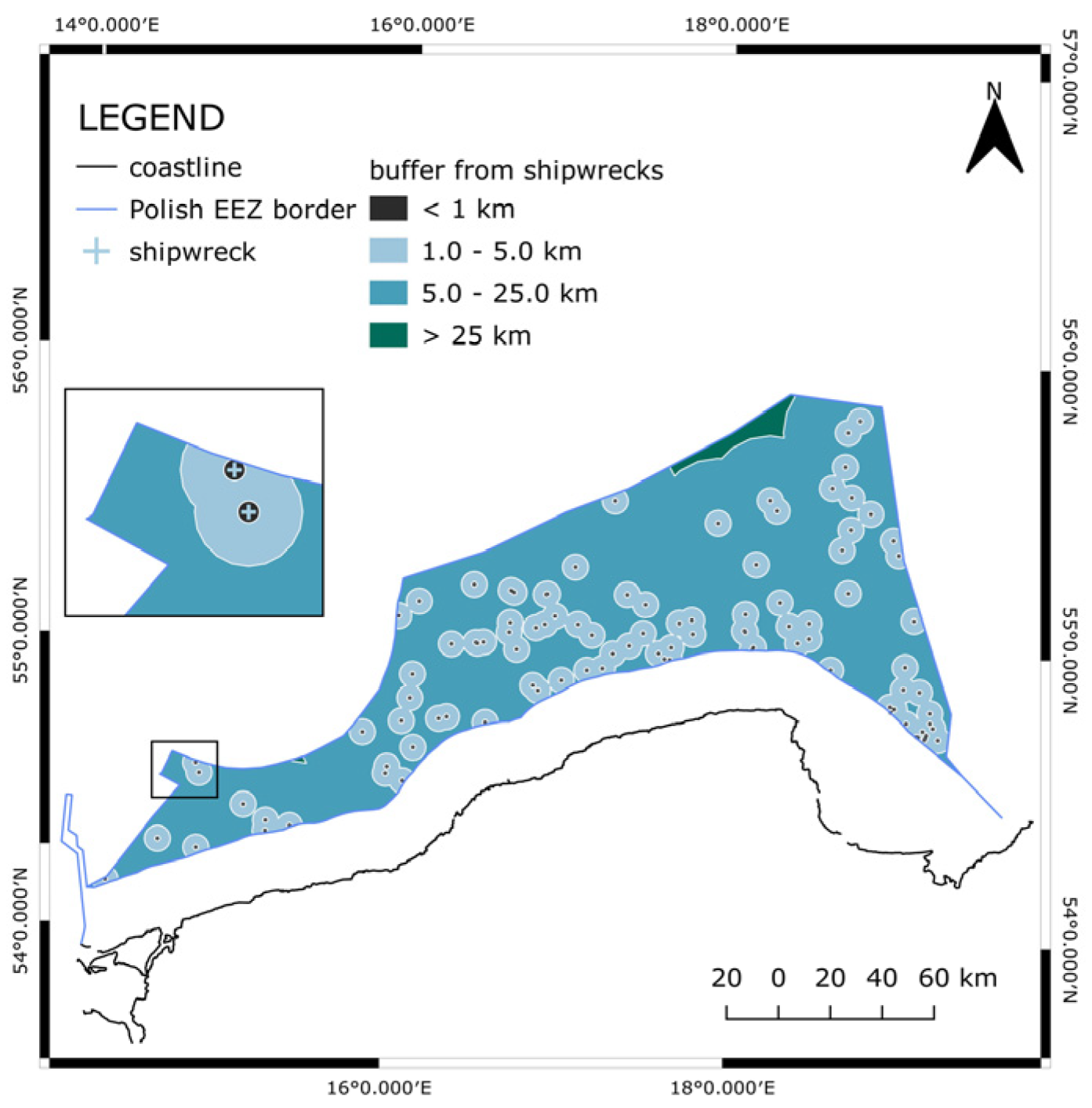
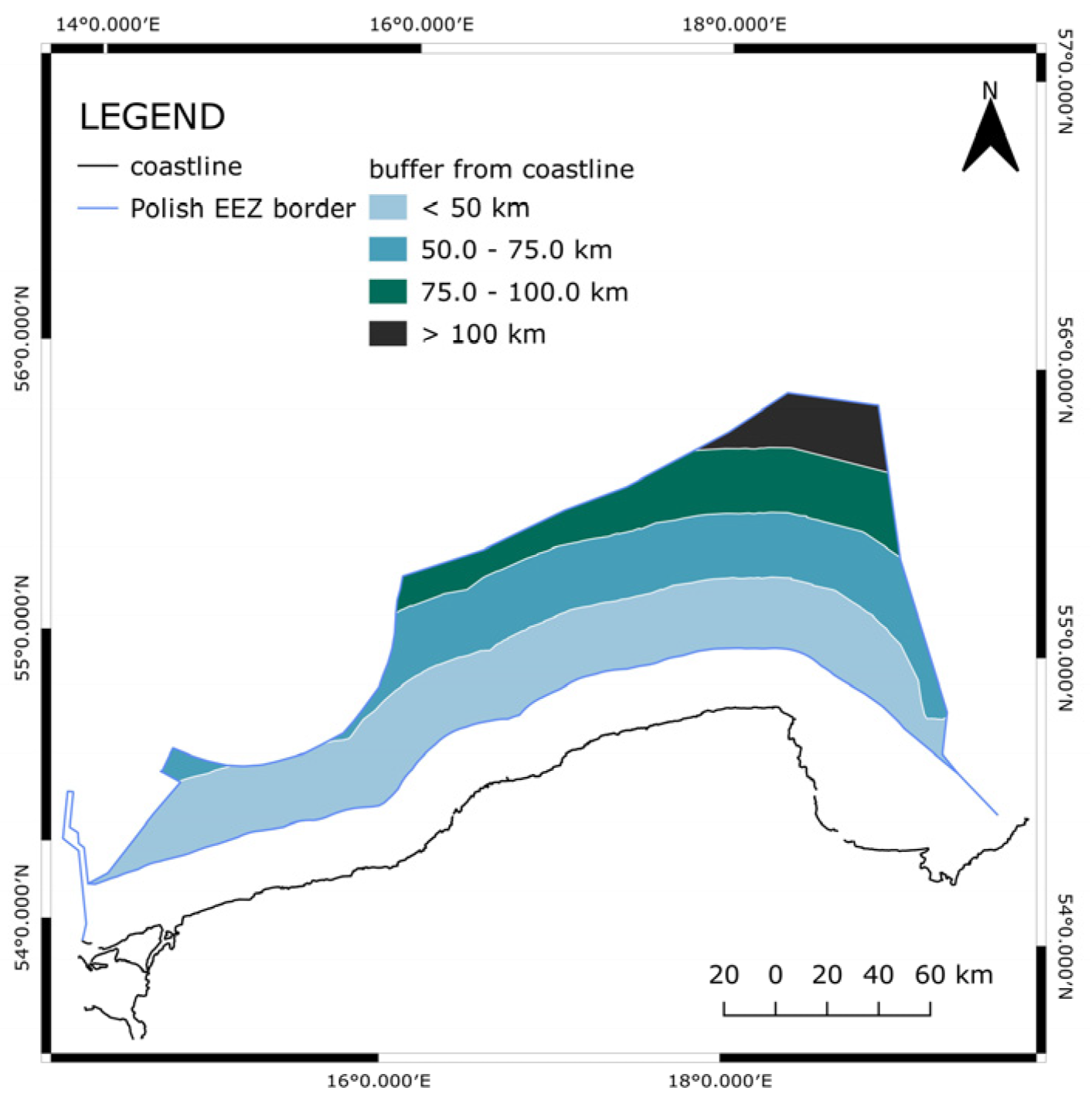


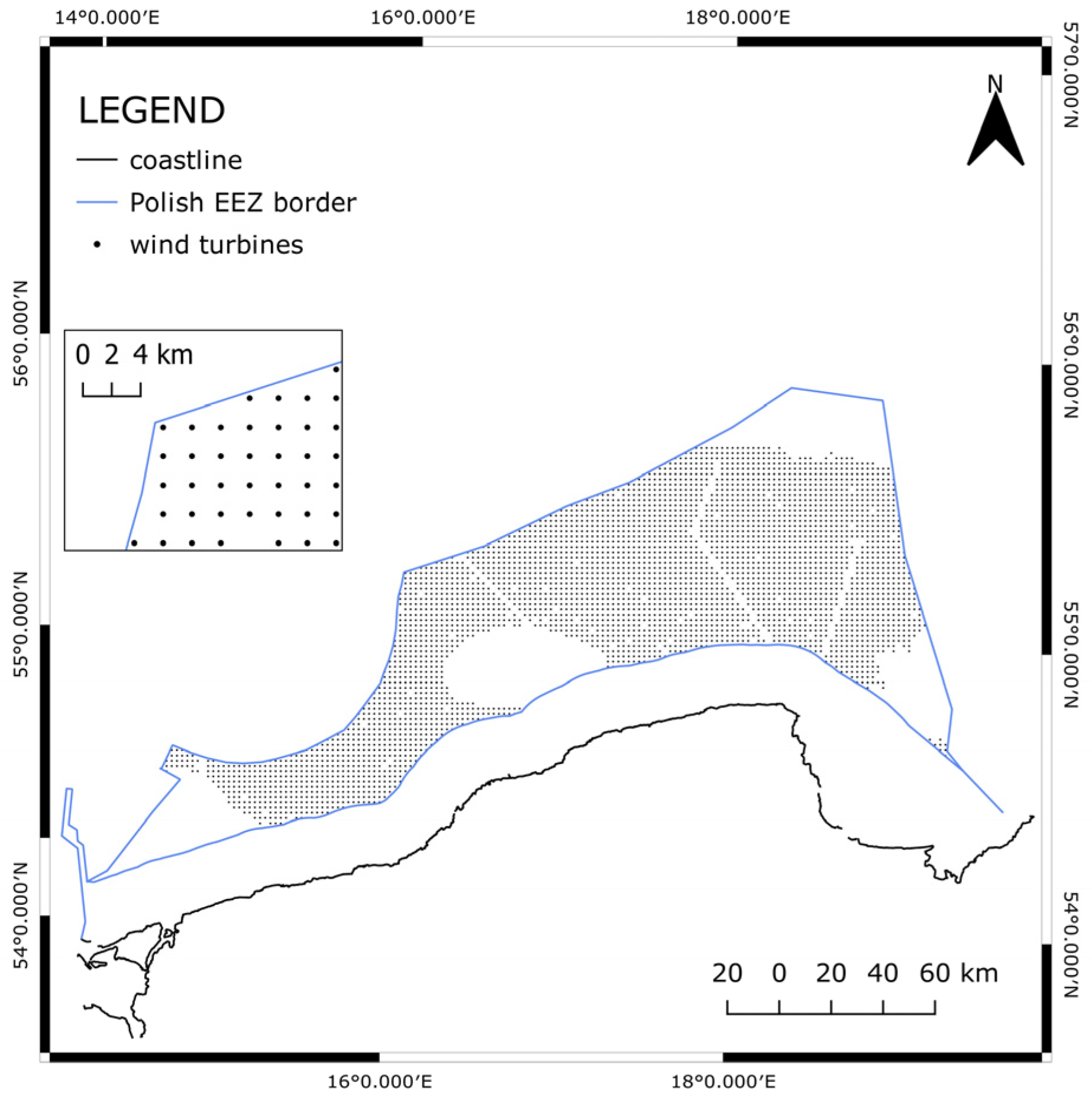


| Category | Criteria | Data Source |
|---|---|---|
| Energy resource and profitability | wind velocity | Global wind atlas [34] |
| water depth | Global wind atlas [34] | |
| Marine environment and marine ecology | distance from nature conservation areas (Natura 2000) | SIPAM [35] |
| Human activities | distance from submarine cables and gas pipelines | SIPAM [35] |
| distance from shipping routes | EMODnet [36] | |
| fishing areas | EMODnet [36] | |
| distance from shipwrecks | SIPAM [35] | |
| Conservation area and view protection | distance from coast | SIPAM [35] |
| EEZ area | SIPAM [35] |
| Criteria | Criteria Weights | Rank |
|---|---|---|
| wind velocity | 0.349 | 1 |
| water depth | 0.167 | 3 |
| distance from nature conservation areas (Natura 2000) | 0.091 | 4 |
| distance from submarine cables and gas pipelines | 0.056 | 5 |
| distance from shipping routes | 0.035 | 7 |
| fishing areas | 0.030 | 8 |
| distance from shipwrecks | 0.052 | 6 |
| distance from coastline | 0.220 | 2 |
| Suitability | Values | Area (km2) | Share |
|---|---|---|---|
| Marginally | 1.494–2.0 | 2178.97 | 10.26% |
| Moderately | 2.0–2.5 | 10,312.76 | 48.56% |
| Highly | 2.5–2.80 | 3726.90 | 17.55% |
| Name of the Project | Investor | Capacity (GW) | Distance to the Land (km) | Area (km2) | Commercial Operational Date (COD) |
|---|---|---|---|---|---|
| Baltic Power | PKN Orlen, Northland Power Inc. | 1.2 | 23 | 130 | 2026 |
| Baltica 1 | PGE | 1 | 80 | 108 | after 2030 |
| Baltica 2 | PGE, Ørsted | 1.5 | 40 | 190 | 2027 |
| Baltica 3 | 1.05 | 25 | 130 | 2026 | |
| BC-Wind | Ocean Winds | 0.399 | 23 | 90.94 | 2028 |
| F.E.W. Baltic II | RWE | 0.35 | 50 | 41 | 2026 |
| MFW Bałtyk I | Equinor, Polenergia | 1.56 | 80 | 128.53 | after 2030 |
| MFW Bałtyk II | 0.72 | 37 | 122 | 2028 | |
| MFW Bałtyk III | 0.72 | 22 | 119.52 | 2028 |
Disclaimer/Publisher’s Note: The statements, opinions and data contained in all publications are solely those of the individual author(s) and contributor(s) and not of MDPI and/or the editor(s). MDPI and/or the editor(s) disclaim responsibility for any injury to people or property resulting from any ideas, methods, instructions or products referred to in the content. |
© 2024 by the authors. Licensee MDPI, Basel, Switzerland. This article is an open access article distributed under the terms and conditions of the Creative Commons Attribution (CC BY) license (https://creativecommons.org/licenses/by/4.0/).
Share and Cite
Przewoźniak, M.; Wyrwa, A.; Zyśk, J.; Raczyński, M.; Pluta, M. Conducting a Geographical Information System-Based Multi-Criteria Analysis to Assess the Potential and Location for Offshore Wind Farms in Poland. Energies 2024, 17, 283. https://doi.org/10.3390/en17020283
Przewoźniak M, Wyrwa A, Zyśk J, Raczyński M, Pluta M. Conducting a Geographical Information System-Based Multi-Criteria Analysis to Assess the Potential and Location for Offshore Wind Farms in Poland. Energies. 2024; 17(2):283. https://doi.org/10.3390/en17020283
Chicago/Turabian StylePrzewoźniak, Magdalena, Artur Wyrwa, Janusz Zyśk, Maciej Raczyński, and Marcin Pluta. 2024. "Conducting a Geographical Information System-Based Multi-Criteria Analysis to Assess the Potential and Location for Offshore Wind Farms in Poland" Energies 17, no. 2: 283. https://doi.org/10.3390/en17020283
APA StylePrzewoźniak, M., Wyrwa, A., Zyśk, J., Raczyński, M., & Pluta, M. (2024). Conducting a Geographical Information System-Based Multi-Criteria Analysis to Assess the Potential and Location for Offshore Wind Farms in Poland. Energies, 17(2), 283. https://doi.org/10.3390/en17020283







